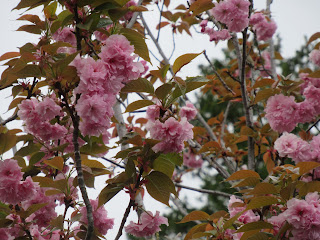Cherry blossoms this year was too early … According to a weather forecaster here, Japanese Meteorological Agency has the 70 years’ record of full-bloom for Somei-Yoshino cherry blossoms. They are in Agency’s 48 observation points, i.e. one for each prefecture of Japanese archipelago. The agency also define how they call it “full bloom.” When 80% of buds of a sample tree at an observation point have opened, they record it as “the date of full bloom.” When we check 70 years’ average for the “full bloom” day of each observatory, there are only 3 places in which their benchmark tree developed completely before the end of March; they are Kochi 高知 (March 30), Fukuoka 福岡 and Tokyo (March 31). Then, this year, all the places south of Miyagui Prefecture 宮城県 have seen the full-bloom before April Fool comes … too early joke.
 |
| This photo
was taken on March 27 this year in Niiharu Citizen Forest 新治市民の森. |
But such restlessness has one caveat. The “official” report of fully blooming Sakura is about Somei Yoshino tree. It’s one breed of cherries among hundreds of kinds. Somei Yoshino was artificially crossbreed in the middle of the 19th century by nurseries in Somei Village which is now Komagome 駒込 and Sugamo 巣鴨 towns of Toshima Ward 豊島区, Tokyo. The mom of Somei-Yoshino was Edo Higan, aka Cerasus itosakura var. itosakura f. ascendens that is wild cherry found in Honshu, Shikoku, and Kyushu islands of Japan, and in Seju Island of South Korea. Edo Higan blooms fully in pink or white before leaves come out, which is inherited by her baby Somei Yoshino. She can grow huge, like 20-30m tall, and live long. It is said that Edo Higan named “Jindai-Sakura,” in Jissoh-ji Temple 實相寺 of Yamanashi Prefecture 山梨県, is 1800 to 2000 years old … As it can have such loooong life cycle, it takes time to develop flowers, sometimes for more than tens of years. I guess nurseries of the 19th century thought there was a room for improvement to make the tree commercial product. They brought dad, Ooshima Zakura, aka Cerasus speciosa that is another Japanese endemic wild cherry spreading in the area south of Kanto region 関東.
 |
| Beautiful and strong mother, Edo Higan. |
Ooshima Zakura has lots of white flowers that open together with leaves. It can be 10-15m tall, not as tall as the mom, but its strength lies in quick coppicing and growth. The tree has no problem of hard coppicing in every 10-20 years. Ooshima Zakura has flavorful aroma in its entire body, if not that strong as roses. Young leaves of Ooshima Zakura are harvested to be salted and used for cooking, including pink Sakuramochi sweet dumplings. The trunks and boughs have fine-texture good enough for nice furniture. People planted them in their Satoyama backyard for harvesting firewood and the other usages. He can cover slowness of Edo Higan, and so, Somei-Yoshino was born. Somei Yoshino grows 10-15m tall like its dad, opens flowers first before leaves like mom and quickly like dad, and spreading its bough widely like its parents. Handsome kid.
 |
| This is called Cerasus ×subhirtella ‘Autumnalis’ Makino that flowers twice in a year: once in autumn, and another in early spring. |
 |
| When you come to Japanese mountainous areas in
early spring, you can often find such slopes dotted or covered white or pale pink with wild cherry blossoms … |
Here are some non-Somei Yoshinos we can casually meet in Kanagawa Prefecture. To start, please enjoy color gradation of cherry blossoms planted in the Historical Landmark for Saimyoji Temple 最明寺史跡公園 (: my post on January 7th 2022). They are all variety of cherries …
 |
| Lots of jamasakura in Yokohama’s Satoyama Garden. |
 |
| This is one of the largest trees in Niiharu Citizen
Forest. It’s Ceresus jamasakura whose diameter is more than 1m. |
Another memorable species is Cerasus itosakura ‘Pendula’ Maxim. Its branches bow down due to the lack of gibberellin, a plant hormone. Such characteristics are recessive inheritance for Edo Higan so that they can appear naturally in mountains. Though the absolute majority of this variety we meet is a cultivar. Here is one of such trees planted in a forestry road of Tanzawa.
And the last entry for the beauty pageant this week is Cerasus incisa, aka Mame-zakura. This is one of 10 or 11 wild cherry endemics in Japan. It is very hardy: can survive -20°C freezing winter, and can make colonies in volcanic soil. It does not grow tall. Some say average height of the species is about 4m. It starts flowers when young, and in general doesn’t thicken more than 10cm in diameter. It has evolved to endure the climate of the subalpine zone. Due to its hardiness and compactness, it is often used as the base for creating cultivars for gardens and bonsais. The variety of Mame-zakura, especially those found around Mt. Fuji has a special name Fuji-zakura. It’s one of the stars for the group of flora named Fossa Magna elements. I’ll return them in my later post. 😉 Please stay tuned!
If you find environmental issues in Kanagawa Prefecture, please make a contact with Kanagawa Natural Environment Conservation Center 神奈川県自然環境保全センター
657 Nanasawa, Atsugi City, 243-0121
〒243-0121 厚木市七沢657
Phone: 046-248-0323
You can send an enquiry to them by clicking the bottom line of their homepage at http://www.pref.kanagawa.jp/div/1644/






No comments:
Post a Comment